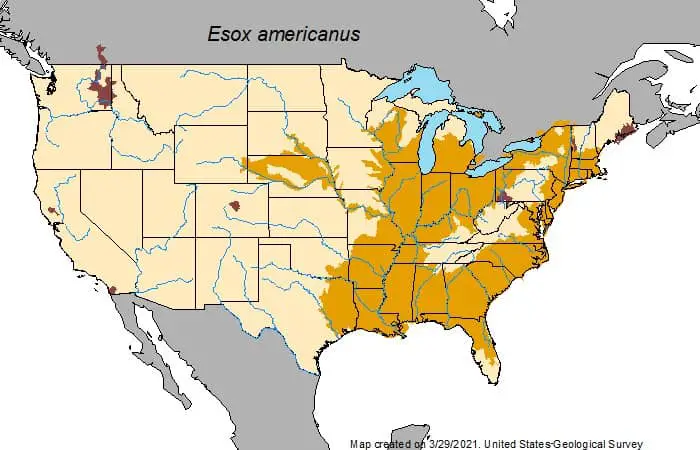While the pickerel side of the Esox family might not get as much attention or love as the northern pike or muskellunge, but that doesn’t mean they don’t have anything to offer sports anglers. Well, some of them, anyway.
The truth is that although the term “pickerel” is often used to refer to four or five fish, there are only three types of pickerel and they are very specific species. Those are chain pickerel, grass pickerel, and redfin pickerel. And no, we didn’t forget one.
American Pickerel is actually a term that applies to both Redfin Pickerel and Grass Pickerel – but they are not the same fish.
The things you learn, right?
Pickerel are an often overlooked sports fish. But they are definitely not all equal when it comes to fishing for what these toothy little guys have to offer.
Chain Pickerel
Chain pickerel are the ones that are most often mistaken for small to middling northern pike, though they very rarely grow even up to five pounds. That said, the world record is around 9 and a half pounds, so there are some examples of full-sized adults that make a pretty reasonable size.
You might not think 5-7 lbs is much but any angler will tell you, get a pike or bass that size on the right fishing rod and it feels like a pretty big deal!

Chain pickerel put up a good fight and can natively be found in many states where pike don’t naturally occur. There is some overlap in places, which once in a while will lead to a fun fight with a hybrid between the two.
Chain pickerel are found mostly in the South and on the East Coast of the United States. There have been isolated reports of them elsewhere, but they aren’t native to those areas.
Named for the chain patter of spots that go down the side, eventually mostly connecting with small lines between them, this fish lives up to its name in appearance and looks very similar to pike in many way because of these patterns.
Pike’s Ornery Little Cousin
The chain pickerel has a reputation as being very similar, though smaller, than its bigger Esox cousin the northern pike. To the point where in the South many anglers do call them Southern Pike (and to be fair, chain pickerel had the name Southern Pike before the Italy variant).
Chain pickerel are aggressive and eat an insane amount as young fish. Many early biologist and naturalist studies in the 1930’s even referred to them as devil fish because of the voracious way they would feed so heavily.
Needless to say, this major appetite and aggressive nature make them quite popular with anglers ranging from Connecticut down to Louisiana.
What Makes Chain Pickerel Stick Out?
- The chain pattern is very distinctive when you know what to look for
- Duck bill-like nose
- Sharper, more distinct fins than the other pickerel which have rounded fins
- Very clear and distinct mark that comes straight down from the eye
- Hardest hitting fish for its size in many states where it’s found
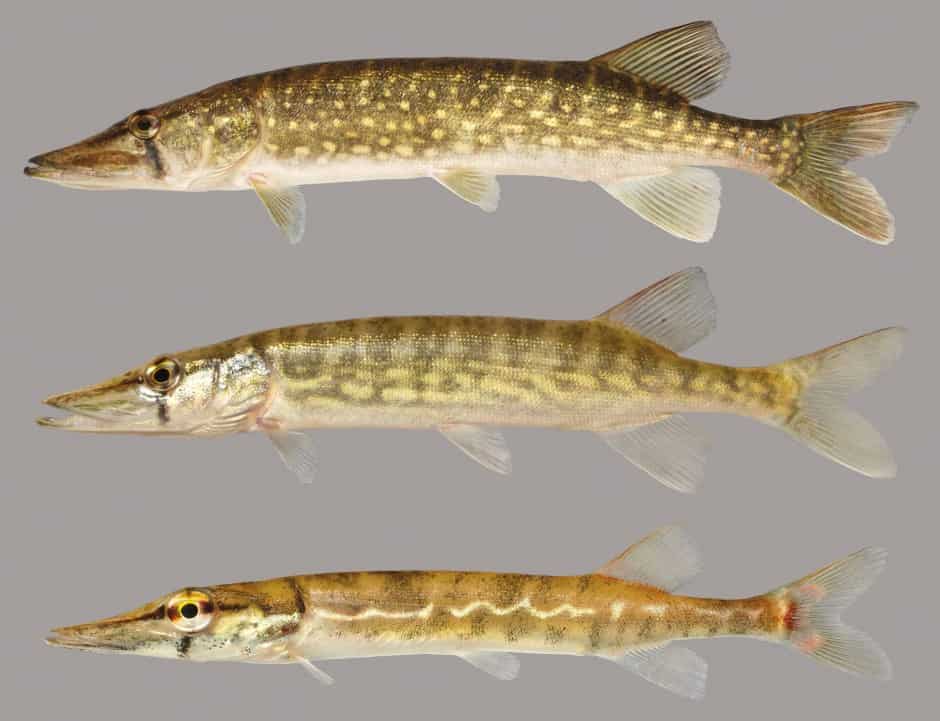
The chain pickerel is popular among many anglers, and goes by many other different names, as well. Just a few of the most popular are: south pike, eastern pike, black pickerel, and occasionally even jackfish or jack (though these are much less common now – still gotta give northern pike the nod as jack fish).
They’re a great fish that tastes pretty dang good, too!
How to Fish for Chain Pickerel
This energetic fish is also like the northern pike in the fact that it is going to fight hard and go after many different types of lures. The best fishing technique will vary based on areas. Chain pickerel will see different baitfish in Maine or Rhode Island compared to Florida or Louisiana.
However if you fish for these the way you fish for pike up north, or bass down south, you’ll almost certainly be in good shape.
With live bait a minnow rig is one of the best options according to several guides I talked to from the Carolina areas. They also recommended baits that looked like local bait such as plastic worms, frogs, or even lizards. Seems like pickerel have a bit of the water wolf in them, as well.
For non-bait lures you can go with tailed spinners, spoons, plugs, and even some top water lures. I’ve heard fly anglers have even caught the occasional pickerel. That must be one heck of a fight!
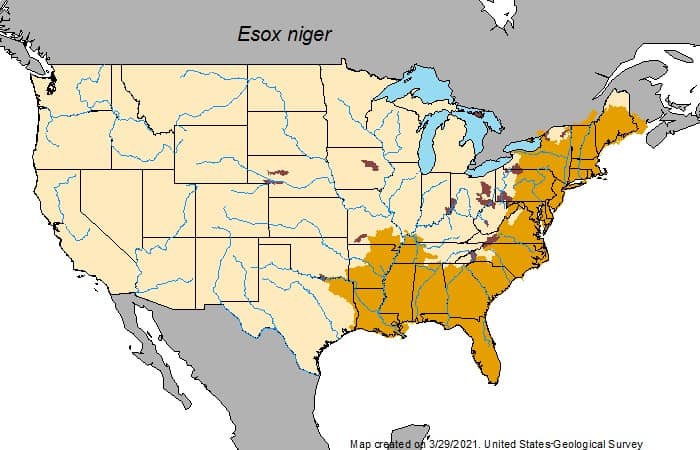
The American Pickerel
So there is a weird overlap when anglers talk about the American Pickerel, which is a name often given to both Redfin Pickerel as well as Grass Pickerel.
This term is often used interchangeably and while technically true, it’s not 100% accurate.
Both grass pickerel and redfin pickerel are considered to be American Pickerel. But they are NOT the same fish.
They are remarkably similar, but there are a couple of important differences that technically make them different species. And as you can see from the various pictures below while they look similar: there are key differences that can help you to tell the two apart.
Grass Pickerel
The American Grass Pickerel is a fish that has the heart of a much larger fish, but the world record is only 2 lbs and the last grass pickerel that size was from decades ago.
But if you catch this 10 ounce Esox it will fight you as if it was a ten pound predator. While they are a bit bony, in large numbers they can be fairly tasty. The key is having someone who knows how to prepare them, as this is sort of an old school fish to grab in bunches out of the fishing hole.

What Makes Grass Pickerel Stand Out?
- Very dark coloration
- North to south bars more similar to a muskie than a pike
- Much smaller size than chain pickerel
- Look particularly “toothy” when small
- Shorter snout
Where can you find the grass pickerel?
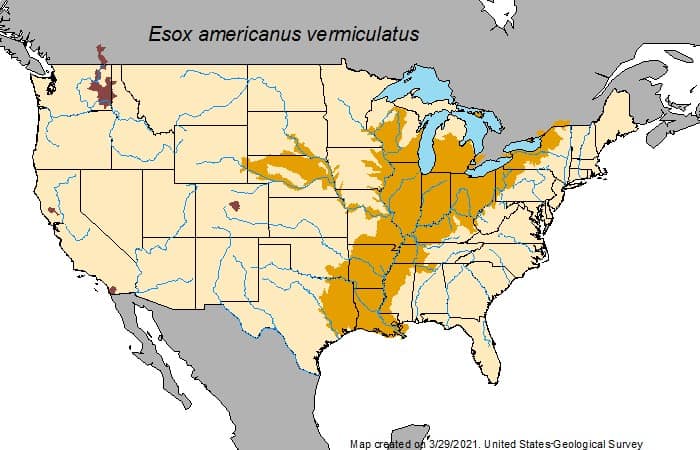
Because they’re smaller they’re not seen as much of a game fish in many areas, and don’t even have the following that the redfin pickerel do in parts of the deep south because of their more limited range.
Redfin Pickerel
Redfin pickerel are interesting. They’re small, they’re toothy, they’re funny looking. And my gut instinct would be that there really isn’t a lot of potential here but I would be wrong. While fishing for “red pike” or “ditch pike” as they are often called down South isn’t as popular as it once was, there are groups of anglers
This article from a North Carolina fishing site does a great job of talking about the tradition of pikin’ in North Carolina – and that was all about the red pickerel and what they brought to fighting a lure and the delicious taste on the dinner table.
And this is definitely a blown up picture of what a redfin pickerel looks like seeing as how they are definitely smaller in size on average. But they are a pretty fish, and I’m eager to accept some of those invitations from phone calls and forums with old school anglers to come on down and see what these guys have to offer both for a fight and in a frying pan.

What Makes Redfin Pickerel Stick Out?
- As the name suggests, a distinctly red coloration on the fins that makes it a dead giveaway as a redfin
- Vertical bars that tend to “dissipate” towards the belly
- Distinctive tear drop from the eye
- Often found in back swamps or creeks in large numbers
Where can the redfin pickerel be found?
What About Pike Pickerel Hybrids?
The only pickerel large enough to breed with pike versus just becoming an instant meal are chain pickerel. And although this is quite uncommon, even less common than the tiger muskies occurring naturally, they do occur. A chain pickerel-pike hybrid has an impressive fight, good tasting meat, and does a lot to combine the best of both. They can also be incredibly hard to tell apart from pike in many cases.
Just take a look at the picture below if you don’t believe me.
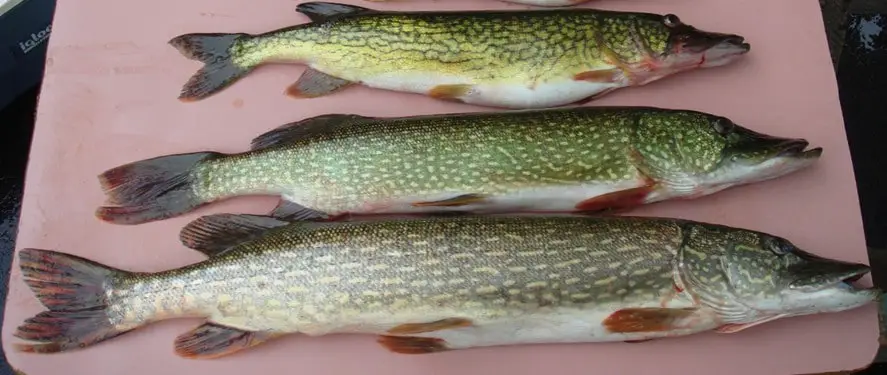
The only pickerel that will potentially mate with a pike, or vice-versa, to create hybrids is the chain pickerel. This is why all hybrids of these fish are going to fit into a chain pickerel/pike lineup – and they can reach fairly impressive size to boot.
Comparing the Three Pickerel Side by Side by Side
The picture below does a pretty good job of showing the differences between them. However, that being said the size is way different between each.
Grass pickerel and redfin pickerel are incredibly small, with many redfin pickerel
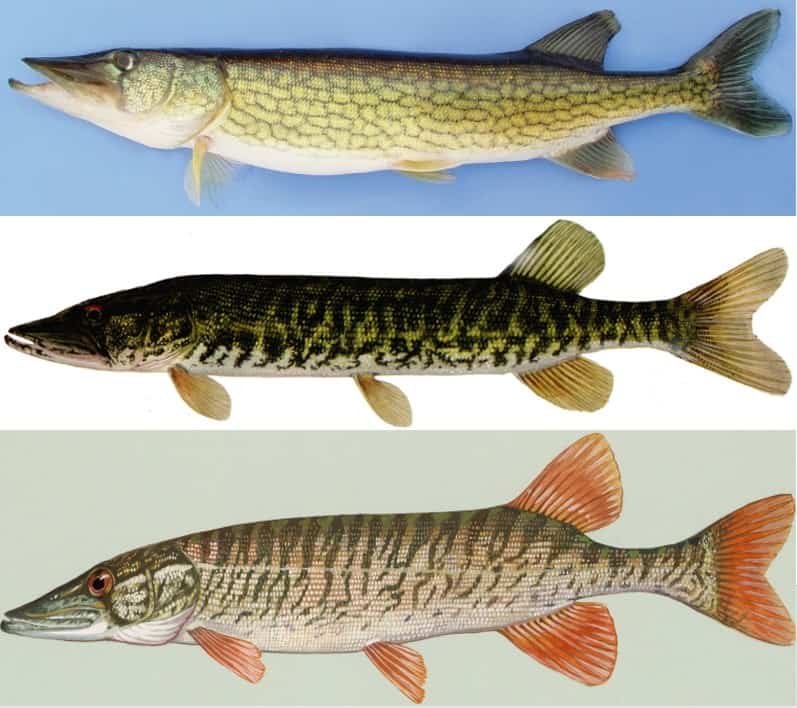
The bottom two rarely get past 12 inches and in the case of the redfin pickerel virtually none get even up to a full pound with most state records measured in ounces.
In Conclusion
While you’re not going to convince a pike angler or a fisherman with muskie fever to abandon those pursuits to chase after the younger cousins in the pike family, that doesn’t mean the pickerel don’t have anything to offer. Chain pickerel tend to be really popular in their area.
While redfins aren’t nearly as sought after in Southern creeks as they used to be, they’re a very tasty meal when cooked up right.
There’s no question the various species of pickerel are definitely the small fry of the Esox family that contains the northern pike, musky, and tiger musky at the top, but hopefully this article showed you what they do have to offer anglers who are willing to cast out and try for something a bit different.
More Articles on Pickerel You May Enjoy
I hope you enjoyed this article and if you’re looking to learn more about pickerel fishing to see if it’s something you want to give a shot or not, then please check out these other pickerel-related articles on the blog.

